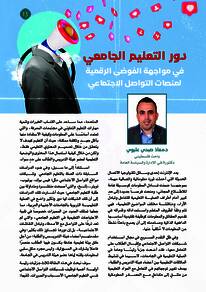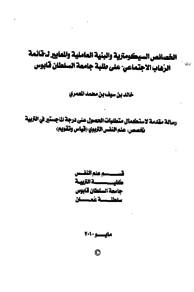Document
وعي الشباب الجامعي بدور شبكات التواصل الاجتماعي في التوعية بمخاطر الجريمة الالكترونية : دراسة وصفية مطبقة على طلبة جامعة السلطان قابوس.
Publisher
جامعة السلطان قابوس
Gregorian
2018
Language
Arabic
Subject
English abstract
The study aims to recognize the reality of the use of social networks by university students, and highlight the awareness of university students of the importance of social networks in combating cybercrime, as well as to recognize the effect of (qualitative & quantitative) variables on university students, and to come up with some suggestions that contribute to the activation of social networks and raising awareness of dangers of cybercrimes.
The study was based on descriptive approach, where questionnaire tool and codifiec interview sheet were used to compile data from (572) students and (4) cybercrimes specialists from government and private organizations
The study has reached various results, including:
- The first part: addressed the reality of using social networks by university students The results revealed that most of the students surveyed did not participate at all ir. awareness campaigns through social networks, and the average of using social networks by the students surveyed range from 3 hours and more with the percentage of 65%. Also, the results revealed that most of the students surveyed prefer to use social networks at home and campus. The results also revealed that smartphones and other similar devices are the most common devices used to access social networks and that the social networks which being used by the students surveyed are varied Whatsapp application is being used by 95.1%; while Instagram is being used by 83.9% and finally 15.7% for Facebook. The motivation for using such socia networks was pleasure and entertainment for 87.2% of the students surveyed learning and study for 84.4% of the students surveyed; then connecting with friends finally 50.3% were motivated by work. The results revealed..that most of the students surveyed prefer to use Whatsapp application with 54.9%, then Instagram and Youtube, and finally Facebook with about 2%.
- The second part: in respect of the awareness of university students about the role of social networks in mitigating cybercrimes; the results showed that misuse of social networks could raise cybercrime rates. Awareness campaigns of the dangers of cybercrimes should include legal articles and penalties. Furthermore, the results showed that using social networks for awareness of dangers of cybercrimes promotes legal awareness and security sense among youth category. - The third part: In respect of the effect of (college & gender) variables on awareness level about the importance of social networks in combating cybercrimes, the results revealed there is no difference in awareness levels about such importance that may be attributed to gender variable among university students, and that there are significant differences according to the college variable for the college of nursing in the first place and college of education in the second place. - The fourth part: It demonstrates the proposed mechanisms for activating social networks to reduce cybercrimes. The results showed the most important suggestions are: to create platforms and accounts on social networks that are specialized in raising awareness of the dangers of cybercrimes; to educate local youth and community about the methods being used by perpetrators in committing cybercrimes through social networks; to cooperate with civil society associations and organizations in raising awareness of the dangers of cybercrimes through social networks; to conduct regular awareness campaigns about the dangers of cybercrimes through social networks; to cooperate with social media pioneers to raise awareness among community through social networks; and to create pages on social networks to review forms of cybercrimes.
Member of
Resource URL
Arabic abstract
هدفت الدراسة إلى التعرف على واقع استخدام الشباب الجامعي لشبكات التواصل الاجتماعي، وإلقاء الضوء على مدى وعي الشباب الجامعي بأهمية شبكات التواصل الاجتماعي في مكافحة الجريمة الالكترونية كما تسعى الدراسة إلى التعرف على أثر المتغيرات ( النوع، الكلية في مدى وعي الشباب الجامعي، وتقديم بعض المقترحات التي تسهم في تفعيل شبكات التواصل الاجتماعي في زيادة الوعي بمخاطر الجريمة الالكترونية
واعتمدت الدراسة على المنهج الوصفي، واستخدمت فيها أداتي الاستبيان وصحيفة المقابلة لجمع البيانات من 572 طالبا وطالبة و 4 من المختصين بالجرائم الالكترونية في المؤسسات الحكومية والخاصة توصلت الدراسة إلى العديد من النتائج، نذكر منها :۔ المحور الأول : تطرق إلى واقع استخدام الشباب الجامعي لشبكات التواصل الاجتماعي، حيث كشفت النتائج أن أغلب المبحوثين لم يشاركوا إطلاقا في حملات التوعية عبر شبكات التواصل الاجتماعي ، ومعدل إستخدام شبكات التواصل الاجتماعي عند عينة المبحوثين تتراوح من 3 ساعات فأكثر بنسبة 65%. وأشارت النتائج أيضا بأن معظم أفراد العينة يفضلون استخدام شبكات التواصل الاجتماعي في المنزل وحرم الجامعة. وبينت نتائج الدراسة بأن الهواتف الذكية وما يماثلها من أجهزة كفية ولوحية من أكثر الأجهزة استخداما للدخول في شبكات التواصل الاجتماعي . وأوضحت نتائج الدراسة إلى تنوع في شبكات التواصل الاجتماعي المستخدمة من قبل أفراد العينة ، حيث حظي تطبيق الواتسب بنسبة استخدام 95 . 1 % ثم الانستجرام بنسبة 83 . 9 % ، كما احتلت شبكة فيسبوك المرتبة الأخيرة بنسبة استخدام 15 . 7 %. وأوضحت النتائج بأن دافع المتعة والتسلية جاء في المرتبة الأولى بنسبة 87 . 2 % ، كما جاء دافع التعلم والدراسة في المرتبة الثانية بنسبة 84 . 4 % يليه دافع التواصل مع الأصدقاء ، وفي المرتبة الأخيرة دافع العمل بنسبة 50. 3 %. وأشارت النتائج بأن معظم عينة المبحوثين يفضلون استخدام تطبيق الواتسب بنسبة 54 . 9 %، يليه الانستجرام واليوتيوب ، كما يأتي الفيسبوك في ذيل القائمة بنسبة لم تتعدى 2%.
واعتمدت الدراسة على المنهج الوصفي، واستخدمت فيها أداتي الاستبيان وصحيفة المقابلة لجمع البيانات من 572 طالبا وطالبة و 4 من المختصين بالجرائم الالكترونية في المؤسسات الحكومية والخاصة توصلت الدراسة إلى العديد من النتائج، نذكر منها :۔ المحور الأول : تطرق إلى واقع استخدام الشباب الجامعي لشبكات التواصل الاجتماعي، حيث كشفت النتائج أن أغلب المبحوثين لم يشاركوا إطلاقا في حملات التوعية عبر شبكات التواصل الاجتماعي ، ومعدل إستخدام شبكات التواصل الاجتماعي عند عينة المبحوثين تتراوح من 3 ساعات فأكثر بنسبة 65%. وأشارت النتائج أيضا بأن معظم أفراد العينة يفضلون استخدام شبكات التواصل الاجتماعي في المنزل وحرم الجامعة. وبينت نتائج الدراسة بأن الهواتف الذكية وما يماثلها من أجهزة كفية ولوحية من أكثر الأجهزة استخداما للدخول في شبكات التواصل الاجتماعي . وأوضحت نتائج الدراسة إلى تنوع في شبكات التواصل الاجتماعي المستخدمة من قبل أفراد العينة ، حيث حظي تطبيق الواتسب بنسبة استخدام 95 . 1 % ثم الانستجرام بنسبة 83 . 9 % ، كما احتلت شبكة فيسبوك المرتبة الأخيرة بنسبة استخدام 15 . 7 %. وأوضحت النتائج بأن دافع المتعة والتسلية جاء في المرتبة الأولى بنسبة 87 . 2 % ، كما جاء دافع التعلم والدراسة في المرتبة الثانية بنسبة 84 . 4 % يليه دافع التواصل مع الأصدقاء ، وفي المرتبة الأخيرة دافع العمل بنسبة 50. 3 %. وأشارت النتائج بأن معظم عينة المبحوثين يفضلون استخدام تطبيق الواتسب بنسبة 54 . 9 %، يليه الانستجرام واليوتيوب ، كما يأتي الفيسبوك في ذيل القائمة بنسبة لم تتعدى 2%.
Category
Theses and Dissertations







